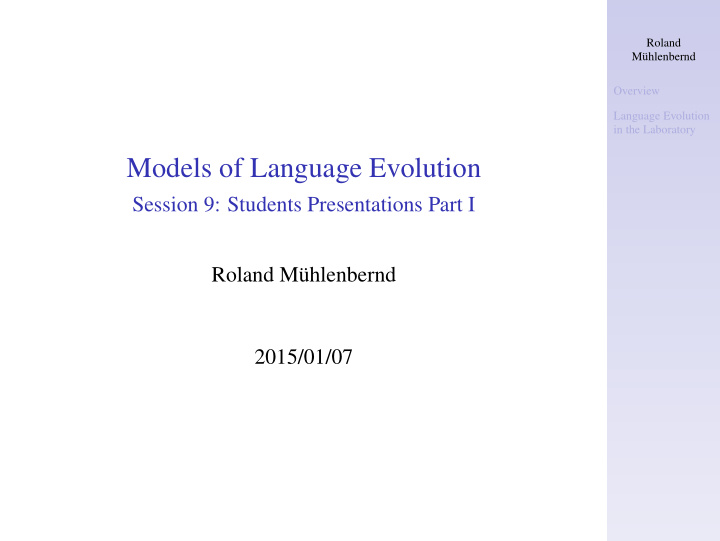



Roland Mühlenbernd Overview Language Evolution in the Laboratory Models of Language Evolution Session 9: Students Presentations Part I Roland Mühlenbernd 2015/01/07
Overview Roland Mühlenbernd Overview date speaker literature / project topic Language Evolution in the Laboratory 7.1 Kameliya Hristova Culture: Copying, Compression, and Conventionality (Tamariz, Kirby 2014) Franziska Koesling Talking to Neighbors: The Evolution of Regional Meaning (Zollman 2005) 14.1 Carina Rüdinger Social Language Learning (Steels 2003) Patrick Zahn Modelling the Cultural Evolution of Language (Steels 2011) Vanessa Nadler Signalling Games: Evolutionary Convergence on Optimality (Lentz, Blutner 2009) 21.1 Larissa Meier Language Structure: Psychological and Social Constraints (Jäger, van Roiij 2007) Clara Baumgärtner Integrating the Horizontal & Vertical Cultural Transmission of Novel Communication Systems (Theisen-White, Kirby, Oberlander 2014) Marcel Binz project topic: signaling & the game of life (Mühlenbernd, Schulz 2014) 28.1 Sabrina Selck project topic: evolution of the lexicon (Steels 1995) Daniel Schuhmacher project topic: communication & changing interaction structure Pink Powerangers prokect topic: evolution of recursive compositionality 4.2 Vivian Fresen project topic: evolution of human vowel systems (de Boer 2002) Team 1 project topic: evolution of compositionality in signaling games Team Nash project topic: evolution of semantic variation (Zollman 2005)
Language Evolution in the Laboratory Roland Mühlenbernd Overview Language Evolution in the Laboratory “...we urgently need a better general understanding of how cultural transmission and social coordination shape language if we are to achieve a complete picture of the evolution of language.” (Scott-Phillips and Kirby, 2010: 110)
Language Evolution in the Laboratory Roland Mühlenbernd Overview Language Evolution in the Laboratory From: Language Evolution in the Lab (Scott-Phillips and Kirby 2010)
Language Evolution in the Laboratory Roland Mühlenbernd Recent Trend: Overview Language Evolution ◮ the development of experimental approaches that use in the Laboratory human participants to observe the emergence of symbolic communication systems ◮ some studies have been explicitly based on and/or inspired by previous computational work Questions ◮ How do these various studies relate to earlier computational work and to other approaches to language evolution? ◮ How do they relate to each other? ◮ What do they tell us about language evolution?
Language Evolution in the Laboratory Roland Mühlenbernd Overview Types of Experiments: Language Evolution in the Laboratory ◮ Meaning Negotiation Game (plus compositionality) ◮ Graphical Communications Tasks (similarity with verbal communication, possibility for innovation, Pictionary-style games) ◮ Iterated Learning Experiments: an artificial languages, consisting of meanings (pictures) and expressions (strings of syllables), is learned and transmitted repeatedly in a chain of participants ◮ Iterated Learning with interaction transmission (vertical and horizontal transmission): vertical transmission requires a learnable system, horizontal transmission a expressive system
Language Evolution in the Laboratory Roland Mühlenbernd Overview Questions for future research: Language Evolution ◮ What are the prerequisites for recognition of communicative intent? in the Laboratory ◮ More generally, what cognitive mechanisms are necessary for inferential communication, and how did they evolve? ◮ Do the results obtained so far scale up to larger populations with more complex dynamics? ◮ Do different population structures influence the way in which language is transmitted? If so, how, and how does this affect linguistic structure? ◮ How do experimental studies in the laboratory relate to studies of language emergence in real human populations? ◮ What is the relative contribution of feedback, interaction and cultural inheritance (and indeed other forms of information transmission) to the form of the final communication system? ◮ Can the results from experimental approaches be used to develop better computational models of language evolution?
Studies of Today Roland Mühlenbernd Overview Language Evolution in the Laboratory 1. Kameliya Hristova ◮ Topic: Culture: Copying, Compression, and Conventionality (Tamariz, Kirby 2014) ◮ Background: Language Evolution in the Lab (Scott-Phillips and Kirby 2010) ◮ Category: Experimental study of vertical transmission 2. Franziska Koesling ◮ Topic: Talking to Neighbors: The Evolution of Regional Meaning (Zollman 2005) ◮ Background: Game Theory, Signaling Games, Stag Hunt Game ◮ Category: Computational study of horizontal transmission
Recommend
More recommend